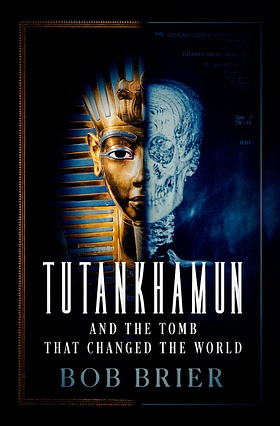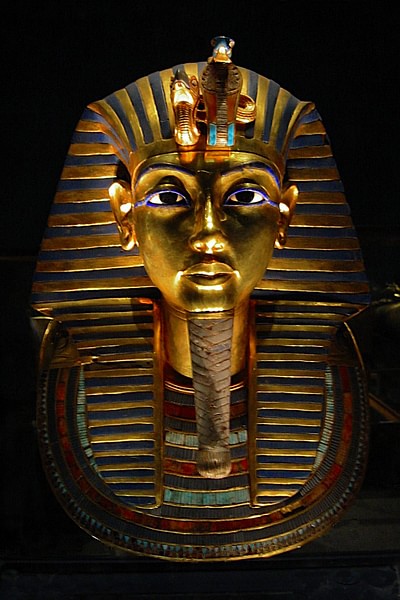Join World History Encyclopedia as they sit down with Dr. Bob Brier to chat all about his new book Tutankhamun and the Tomb That Changed the World, published by Oxford University Press.

Kelly: Welcome. Thank you so much for joining me today, Bob.
Bob: Thanks, Kelly. Glad to be here.
Kelly: Do you want to tell us a bit about what your book is all about?
Bob: I did the book with a very specific purpose. Most people know the story of the discovery of Tutankhamun. It is one of the stories that people love to hear again and again and again of the impoverished archaeologist Howard Carter who hooks up with a wealthy Lord Carnarvon, and they make the discovery of the century. People are familiar with that. What a lot of people do not realise is that research has been going on since then. Meaning, okay, so it takes ten years to excavate the tomb. There are so many treasures in it. They are so fragile, they have to be preserved. After ten years, everything is sent to the Egyptian Museum in Cairo, placed in cases on display, and people think that is where the story ends, but it is not.
Since all those objects have been sent to the Egyptian Museum in Cairo, there have been loads of research projects on the objects, and we are finding out things about Tutankhamun all the time. The reason I wrote this book is to show people how much new we have learned about Tutankhamun, what research looks like when you are doing research on a dead pharaoh, and things like that. So, I want people to see that there is high-tech stuff going on about Tutankhamun all the time, and our view of him is changing quite a bit.
Kelly: Wow. So, are you working on the mummy itself as well in this book, or do you just talk about some of the artefacts?
Bob: The answer is yes, we are doing all of that, Kelly. My specialty is mummies. I am a specialist with mummies. Most Egyptologists have specialties. Some guys are translators, other guys are excavators, and mine is mummies. So, when an interesting mummy is found on an excavation, sometimes I am called in to work on the mummies. One of my interesting things about Tut, the interest started when I examined the foetuses of Tutankhamun. You know, there were two foetuses, little mummified foetuses, found in Tutankhamun's tomb. He died at the age of 19, and his wife is also about 19 when he dies, they are both teenagers. But his wife Ankhesenamun had two miscarriages, two little girls, and they were mummified; they were in the tomb, and they disappeared for years. They were put in storage, and it took me a couple of years to find them, but I found them, so I examined the foetuses. I talk a little bit about that, but I talk more about the mummy of Tutankhamun himself because there has been a lot of research done, and some things said about the mummy I think are wrong, and I want to correct the record.
For example, it is generally accepted now, I think, that Tutankhamun had a club foot. About ten years ago, Tutankhamun was CAT scanned, and many of the researchers thought that the CAT scan showed that he had a club foot and then suggested that he walked on the side of his foot. So, he would have been a disabled pharaoh, and that has generally been accepted. But when I started going back and looking at the records, looking at the CAT scans and everything, it looks like he was not a disabled pharaoh, he did not have a club foot and I am not alone in thinking that, but I am alone in saying it right now. For example, one thing that started me wondering was that the mummy had been examined by two anatomists before the CAT scans, and they never noticed anything unusual about his ankle. So, it puzzled me, and then when I looked at the CAT scan, it was not clear that he had a club foot. Then I thought, what about his feet? The lower limbs would be disfigured also because if you walk on the side of your foot, it is going to affect the lower bones of your legs, the tibia and fibula, and they are perfectly normal. Even the pelvis would be changed. He did not have any of that. Further, when I started looking at his shoes, there were about two dozen shoes buried with him in the tomb – he had to take them to the next world, right? – but his shoes are perfectly symmetrical, too, and if you walk on the side of your foot, dragging it, certainly the shoes would be worn out. So, all of the evidence really changed completely when I looked at the mummy, and it now seems to me as if he was a perfectly healthy teenager.
Kelly: That is incredible! You are sort of restarting the story of Tutankhamun from what we thought we knew.
Bob: Yes! It has a deeper effect also because everybody felt, well, since he was a fragile pharaoh he certainly could not have gone off to war. But then that changes, and recently there have been some blocks discovered in Tutankhamun's mortuary temple where he was worshipped after he died and they show him in battle at war. I think he may have actually gone to war. Another bit of research on Tutankhamun is there was a suit of armour buried with him and people do not know that. It was in terrible condition. It was leather. It is like leather scales that are cut out, and they are all sewn together to form armour. Leather degrades over thousands of years, and nobody wanted to work on it or touch it. But recently some experts have been working on it and restoring it, and it looks like not only did he have a suit of armour, but it had been worn; it shows signs of wear. So, I think I have a chapter in the book on Tutankhamun as a warrior, that he may have been a warrior and that is changing things.
Kelly: Why did you decide to write this book about Tutankhamun and the things found in his tomb?
Bob: Well, this is the 100th anniversary of the discovery of the tomb, so there has been a lot of interest in Tutankhamun. But also, along with that, there's a new museum being built in Cairo called the Grand Egyptian Museum. And all of Tutankhamun's objects are being moved from the old museum in Cairo out to Giza to the new museum. So, while they are coming out of the cases, there has been all this new research, being able to get our hands on objects, actually see them, touch them, and take photographs of them. There is so much more information now because of this 100th anniversary and the Grand Museum, and there is just so much stuff coming out that I thought it would be interesting to tell people about it.
Kelly: Did you go into this book with the idea that you would be writing something brand new, or did you think that it would just be like an updated version of things that we already knew?
Bob: No, I thought I had new information. I knew that there was this new research, and I had done a little bit of research. There were more new things than I thought; when I started putting the pieces together, I was surprised. For example, one of the things that we knew about Howard Carter is that he took things from the tomb and did not return them. Shame on him. But he was not interested in selling them. It was not for profit or anything like that. But he sort of had this feeling, almost that he owned the tomb. Remember, this is 1922 when it was discovered, and England is ruling Egypt. It is a colonial situation. So, in a sense, he is in charge. He is taking things, and he is giving them to friends as souvenirs of the tomb. We knew that.
I started researching that and found letters that Egyptologists had written about Carter taking things, and they were kind of shocking. Really surprising, the extent to which Carter took things and the sort of feeling of entitlement. For example, the walls were sealed with the Necropolis seal of the nine jackals, pretty impressive seals, and he gave them away. He gave them to Sir Alan Gardiner, who was an Egyptologist and Gardiner gave them to his kids. There were necklaces that disappeared and appeared in museums around the world. I discovered that he was really doing more pilfering than we thought. We knew that it happened, but this was more than I thought. So, I discovered quite a few things that I did not know. That is half the fun of doing a book. You do the research, and then you make discoveries, and it is exciting.
Kelly: Would you say that was the most surprising thing when you were researching and working on the book or was there something else that really fascinated or surprised you whilst writing it?
Bob: To tell you the truth, there were quite a few things that surprised me. One chapter I really loved and was a lot of fun doing was the one called It Came from Outer Space. Now, I do not know if you guys have it, but we have this dreadful show called Ancient Aliens. It is a TV show that talks about how ancient aliens came to Earth years ago and stuff like that. It is dreadful. I had to call my chapter It Came from Outer Space, but I think a lot of people are going to be disappointed. It does not deal with ancient aliens. There are no spacecrafts discussed, but some of the objects in Tutankhamun's tomb did, in fact, come from outer space. Now, you are wondering. I can see a little puzzled look on your face.
There was no iron in Egypt. Egypt did not have iron. It had copper and it had tin, and it could make bronze, which is a combination of copper and tin. But it did not have iron in Tutankhamun's time. But there were five or six iron objects found in Tutankhamun's tomb. Now, where did they come from? They are meteoritic. They were made from meteorites. So, meteorites landed or came, and then somebody pounded out these objects from them. And some are quite beautiful. There is a beautiful dagger, an iron dagger that Tutankhamun was buried with a rock crystal handle, and it is just beautiful, and it is made out of meteoric iron. He had other objects, too, and I think these were very magical objects because they were so precious, because they did not have iron. So, he was buried with six or so meteorite irons, and that is kind of interesting.
One thing that does not make any sense at all to me is that he had a set of chisels. Now, when I say chisels, I mean like workman's chisels. They are wooden-handled with metal bits made out of meteoritic iron. They are not particularly fancy, they are not worthy of a king. They almost looked like they were left behind in the tomb by a workman or something, but they were there in the tomb, so it is kind of curious. Most of the objects are precious. I mean, there is a little amulet of an eye, there is a beautiful pectoral thing, but this chisel set puzzles me. I do not know why he had it. He would not have used it in real life; I am sure he did not do his own chiselling. He had people to do that for him. There were lots of fun things discovered in the tomb that are kind of interesting.
Kelly: Would it be plausible to think that the chisel set was left behind by someone? Because I know that he died unexpectedly. He was so young, and the tomb was put together quickly and some things were reused or repurposed for him. Is that plausible that maybe a builder did just leave it in there?
Bob: I think so. I think that there must have been a rush to bury him. He is mummified, get him in the tomb, and almost all the craftsmen in the country were working on these things for Tutankhamun's tomb. They only had 70 days because the pharaoh has to be buried in 70 days. That was a religious ritual. So, they have got to get all these things, all these treasures, so they are even borrowing things from other tombs. They are taking things out of other tombs, royal tombs, putting them in there, and they are repurposing things. So, for example, in the case of his sarcophagus, the rectangular box was redone from somebody else's. And even the lid is made of a different stone, so the lid cracked, they tried to fix it, but they had to do another lid. There are all kinds of indications of haste, and I think these chisels may have been just left behind by the workmen.
Kelly: Because they are moving all of the things from one museum to the other, have there been things that have turned up that you did not even know were found 100 years ago? Were there things that were not documented?
Bob: Everything was documented fairly carefully. Howard Carter, when he did the excavation, set new standards for excavators. He is the first one, I believe, who photographs everything in situ in the tomb before it is moved so that we have a complete record of what did it look like when he discovered it. Every object has a little card, they put a number in front of it, and they photograph everything. We know everything that was in the tomb pretty well. So, no big surprise. But what did happen over the course of the years, not everything was put on exhibition in the Cairo Museum. Some were put in the storerooms. For example, the chisels. Nobody was interested in the chisels, so they went into the storeroom. A lot of things went missing temporarily. They were in storerooms; they were put away. So, now that everything is going over to this new Grand Egyptian Museum, some things were rediscovered. For example, I had never known about the suit of armour that he was buried with because that was not on display due to its poor condition.
Or, for example, one thing that has been examined now is the collection of 30-40 pairs of shoes that he went to the next world with. A separate study has been made of the shoes; they are really quite interesting. He had lots of sandals. Now, he was buried with sandals on his feet. They were solid gold, not usable, and not practical at all. Gold is very soft. These were his sandals for eternity; gold never tarnishes. For the next world, you want things in gold. So, he was buried with gold sandals, but he had other sandals that had mosaics on top of the bottom, where his foot would touch. And the mosaic was of captives, his enemies. So, every place he would walk, he would step on his enemy. You have these bound Assyrians, bound Nubians, and bound Libyans. It shows them all in their native garb, and Tutankhamun would walk on them wherever he goes. It is interesting to see how they made sandals. So, for example, there were made of reeds that are bundled together, tied together, and they are still beautiful, and elegant, but they are just made so minutely. There are loads of things to learn about from this, by handling, by getting them out of the cases, by finding things in storerooms. It is just remarkable what we are finding about Tutankhamun.
Kelly: Incredible!
Bob: It has got new things and I do go against some of the traditional theories about Tutankhamun. Tutankhamun's tomb is very small, just a couple of rooms, because they did not have a long time to build it over 20 or 30 years. So, it is very modest in terms of size. One of the theories is that his mother was buried behind the wall; she died first, was buried behind the wall, and the wall was plastered over. There has been a lot of discussion about this. Tutankhamun's paintings were very carefully studied recently with laser technology so that we can get a really careful topography of the wall. We know the bumps in the wall. We know everything about the wall. Now, one of the things that were discovered is that there is a part of the wall that has been repainted in modern times. In modern times, meaning the 1920s, and the 1930s.
Now, how did that happen? I think it is a straightforward answer. Maybe not. Howard Carter was an artist. He started his career as a 17-year-old artist on an excavation in Egypt. And he was very good at it, but he was also very bright, and they realised he had even more talent than art, and he became an excavator, and eventually a chief inspector for the Egyptian Antiquity Service. So, he really had lots of skills, but he had this basis in art, he was an artist. What I think happened is the following.
There is a scene on the wall of Tutankhamun wearing a pleated kilt, and this kilt which was photographed in 1922 has a certain number of pleats. If you look at it today, it has got a different number of pleats. Completely different! And what happened? This is my suggestion. I think when Carter was moving things in and out of the tomb, he damaged the painting and then later he painted over it. He did not just paint over it, though. On the walls of the tomb is mould, 3,000-year-old mould. When they buried Tutankhamun, they did not have time to leave the tomb open so the paint could dry. So it was closed while it still had moisture in it and mould could grow on it. So the mould grew on it for maybe a couple of years and then dies. There are mould spots all over the tomb. When Howard Carter repainted the kilt, he painted fake mould on it so that it would not look new. Nobody knew about this for like 70 years until a scholar got to look close up at it, and he noticed, hey, there is a different number of stripes on the kilt. This is the kind of thing that I like discovering.
Kelly: My last question is what is something that you think everybody should know about your book?
Bob: I think it is the basic thing, I think is that there is a lot of new research on Tutankhamun, it is evolving, and he may not be the boy king who is fragile, never went to war, etc. All this research is helping us paint a much better picture of Tutankhamun.
Kelly: Brilliant. Thank you so much, Bob. Now, Bob's book, Tutankhamun and the Tomb that Changed the World will be available to purchase from Oxford University Press on October 27! Thank you so much for joining me today. It has been a pleasure talking to you.
Bob: A lot of fun for me, Kelly. Take care.












